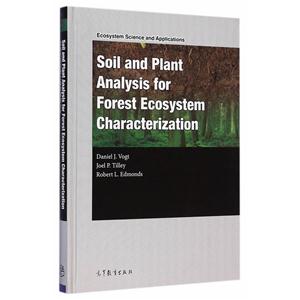ContentsPart I Context of Soil and Plant Analysis1 Overview of Soil and Plant Analysis for Forest Ecosystems1.1 Soils are Physically.Chemically and Biologically Complex
Part II Introductory Methods in Soil and Plant Analyses2 Field Characterization of Soils to Establish Sampling Protocols2.1 Soil Sampling Design and Methods2.1.1 Introduction to Sampling Design2.1.1.1 Accuracy,Bias,and Precision2.1.1.2 General Considerations on Soil Sampling2.1.1.3 Common Sampling Tools and Techniques2.1.1.4 Soil Sample Preparation2.1.2 Soil Sample Process Procedure2.1.2.1 Sample Variability Number of Samples Required3 Plant Tissue Characterization3.1 Tissue Sampling3.2 Tissue Preparation and Laboratory Extraction4 Introduction: Laboratory Practices.
4.1 General Laboratory Protocol4.1.1 Safety4.1.2 Laboratory Water4.1.3 Cleanup4.1.4 Waste DisposalPart III Soil Physical,Chemical and Biological Analyses5 Methods for Analyzing Soil Physical Characteristics5.1 Soil Moisture5.1.1 Direct Methods of Estimating Soil Moisture and Soil Water Potential5.1.2 Procedure to Determine Gravimetric Water C0ncentrations5.2 Soil Bulk Density5.2.1 Soil Bulk Density Methods5.3 Soil Texture ( Particle Size Analysis or Mechanical Analysis )5.3.1 Soil Texture Methods535.3.1.1 Soil Texture Procedure:Bouyoucos Hydrometer Method5l5.4 Soil Water Potential585.4.1 Pressure Plate Apparatus Procedure:Soil Moisture Release Curve6 Soil Chemical Characterization6.1 Soil pH706.1.1 Measuring pH6.1.2 The Care of pH Electrodes6.2 Electrical Conductivity(EC)6.2.l Saturated Paste Extract Procedure:Electrical Conductivity6.3 Ion Exchange in Soils6.3.1 Cation Exchange Capacity.
6.3.2 Exchangeable Cations866.3.3 Extraction Procedures for Exchangeable Cations and Cation Exchange Capacity6.4 Exchangeable Soil Acidity6.4.1 Extraction Procedures for Exchangeable Soil Acidity6.4.1.l Exchangeable Acidity(Barium Chloride Triethalnolamine Method)6.4.1.2 Exchangeable Acidity(Potassium Chloride Methodl6.5 Extractable Inorganic Soil Nitrogen6.5.1 Extraction Methods for Inorganic Soil Nitrogen6.5.1.1 Single Extraction Procedure: Extractable Inorganic Nitrogen6.5.1.2 Double Extraction Procedure:Mechanical vacuum Extractor6.6 Soil Phosphorus6.6.1 Methodology for Measuring Soil Phosphorus6.6.2 Procedure:Extractable Inorganic Phosphorus6.7 Soil Carbon and Organic Matter6.7.1 Dry Combustion Procedure:Total Soil Carbon and Nitrogen6.7.2 Loss on Ignition(LOI)Procedure:Total Soil Organic Matter6.7.3 Walkley Black Procedure:Soil Carbon6.8 Selective Dissolution of Iron and Aluminum6.8.l Extraction Procedure:Organically Complexed Iron and Aluminum6.8.2 Extraction Procedure:Non.crystalline Soil Iron and Aluminum Oxides7 Total Plant and Soil Nutrient Analysis(Digestion)7.1 wet Oxidation Method7.2 Dry Oxidation Method7.3 total Dissolved Carbon and Nitrogen in Water7.4 Modified Kjeldahl Digest Procedure:Sulfuric Acid Digest for \"Total\"Nutrients7.5 \"Tbtal\"Nutrient Analysis Procedure:Dry Ashing Followed by Nitric Acid Digest7.6 Total Dissolved Nitrogen in Water Procedure:Persulfate Oxidation8 Soil Biology Characterization8.1 Soil Microbes8.1.1 Archaea and Bacteria8.1.2 Fungi1378.1.3 Soil Algae and Cyanobacteria ( Blue-green Algae)8.2 Methods for Determining Soil Microbial Diversity and Populations Numbers and Biomass8.2.1 Direct Culture,Microscopy and Image Analysis8.2.2 Microbial Numbers and Microbial Biomass8.3 Mycorrhizas1408.3.1 Types of Mycorrhizas8.3.2 Sampling Mycorrhizas8.3.2.1 Sampling Design8.3.2.2 Collection of Root and Soil Samples8.3.2.3 Storage of Samples8.3.2.4 Determining Mycorrhizas in Samples8.3.3 Determination of Mycorrhizal Fungal Species8.3.3.1 Analysis of Sporocarps and Spores8.3.3.2 Morphotypes of Ectomycorrhizas8.3.3.3 Trap Cultures for A~buscular Mycorrhizal Fungi8.3.3.4 DNA and Biochemical Techniques8.3.4 Ectomycorrhizal Quantification8.3.5 Identification of Ectomycorrhizal Sporocarps8.3.6 Quantification of Arbuscular Mycorrhizal Colonization8.3.6.1 Staining8.3.6.2 Gridline Intersection Method with a Dissecting Microscope8.4 Indirect Indices for Soil Biological Activity8.4.1 Soil Respiration8.4.1.1 C02 Gas Sampling8.4.1.2 The Soda Lime Technique8.4.2 Decomposition Rates of Litter8.4.2.1 Fine Litter8.4.2.2 W00dy Debris8.4.2.3 Fine Woody Debris8.4.2.4 Coarse Woody Debris (CWD)8.4.2.5 Standard Substrates8.4.2.6 Calculation of Decomposition Rates8.4.3 Soil Enzymes8.4.4 Functional Biodiversity-Phospholipid Ester-linked Fatty Acids(PLFA) and Substrate Utilization Profiles8.4.5 Molecular Tools for Ecological Systems8.4.5.1 DNA Extraction from Soil8.4.5.2 PCR8.4.5.3 Restriction Length Fragment Polymorphism RFLP8.4.5.4 Primers8.4.5.5 Gel Electrophoresis8.4.5.6 DNA Sequencing8.4.5.7 Metagenomics and Transcriptomics8.5 Soil Invertebrates8.5.1 Macrofauna with Emphasis on Earthworms8.5.1.1 Extraction Methods8.5.2 Mesofauna8.5.2.1 Mires and Collembola8.5.2.2 Enchytraeids8.5.3 Microfauna8.5.3.1 Protozoans8.5.3.2 Rotifers8.5.3.3 Tardigrades8.5.3.4 MicrofaunaNematodes8.6 Nitrogen Transformations8.6.1 Nitrogen Fixation8.6.1.1 Acetylene Reduction8.6.1.2 N Accretion through Time8.6.1.3 15N Based Methods8.6.2 Denitrification8.6.2.1 The Acetylene Inhibition Method8.6.2.2 15N Tracer Methods8.6.2.3 Direct N2 Quantification8.6.2.4 Mass Balance Approaches8.6.2.5 Stable Isotope Approaches8.6.2.6 Approaches using in situ Gradients in Environmental Tracers8.6.2.7 Molecular ApproachesAppendicesReferencesSubject Index





















